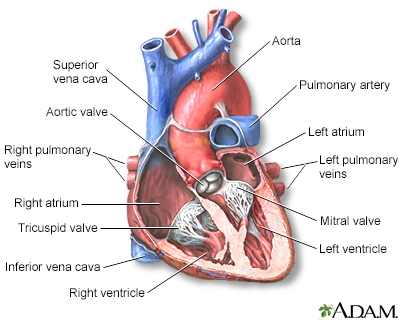SVC obstruction
Superior vena cava obstruction; Superior vena cava syndrome
SVC obstruction is a narrowing or blockage of the superior vena cava (SVC), which is the second largest vein in the human body. The superior vena cava moves blood from the upper parts of the body to the heart.
Images

Causes
SVC obstruction is a rare condition.
It is most often caused by cancer or a tumor in the mediastinum (the area of the chest under the breastbone and between the lungs).
Other types of cancer that can lead to this condition include:
- Breast cancer
- Lymphoma
- Metastatic lung cancer (lung cancer that spreads)
- Testicular cancer
- Thyroid cancer
- Thymus tumor
SVC obstruction can also be caused by noncancerous conditions that cause scarring. These conditions include:
- Histoplasmosis (a type of fungal infection)
- Inflammation of a vein (thrombophlebitis)
- Lung infections (such as tuberculosis)
Other causes of SVC obstruction include:
- Aortic aneurysm (a widening of the artery that leaves the heart)
- Blood clots in the SVC
- Constrictive pericarditis (tightening of the thin lining of the heart)
- Effects of radiation therapy for certain medical conditions
- Enlargement of the thyroid gland (goiter)
Catheters placed in the large veins of the upper arm and neck may cause blood clots in the SVC.
Symptoms
Symptoms occur when something blocks the blood flowing back to the heart. Symptoms may begin suddenly or gradually, and may worsen when you bend over or lie down.
Early signs include:
- Swelling around the eye
- Swelling of the face
- Swelling of the whites of the eyes
- Distended veins in the neck
The swelling may be worse or more prominent when lying down than when upright. It may be worse in the early morning hours and may go away by mid-morning.
The most common symptoms are shortness of breath (dyspnea) and swelling of the face, neck, trunk, and arms.
Other possible symptoms include:
- Decreased alertness
- Dizziness, fainting
- Headache
- Reddish face or cheeks
- Reddish palms
- Reddish mucous membranes (inside the nose, mouth, and other places)
- Redness changing to blueness later
- Sensation of head or ear fullness
- Vision changes
Exams and Tests
The health care provider will perform a physical exam, which may show enlarged veins of the face, neck, and upper chest. Blood pressure is often high in the arms and low in the legs.
If lung cancer is suspected, a bronchoscopy may be done. During this procedure, a camera is used to view inside the airways and lungs.
Blockage of the SVC may be visible on:
- Chest x-ray
- CT scan of the chest or MRI of chest
- Coronary angiography (a heart blood vessel study)
- Doppler ultrasound (sound wave test of the blood vessels)
- Radionuclide ventriculography (nuclear study of heart motion)
Treatment
The goal of treatment is to relieve the blockage.
Diuretics (water pills) or steroids (anti-inflammatory drugs) may be used to temporarily relieve swelling.
Other treatment options may include radiation or chemotherapy to shrink the tumor, or surgery to remove the tumors. Surgery to bypass the obstruction is rarely performed. Placement of a stent (tube placed inside a blood vessel) to open up the SVC may be performed.
Outlook (Prognosis)
The outcome varies, depending on the cause and the amount of blockage.
SVC obstruction caused by a tumor is a sign that the tumor has spread, and it indicates a poorer long-term outlook.
Possible Complications
The throat could become blocked, which can block the airways.
Increased pressure may develop in the brain, leading to changed levels of consciousness, nausea, vomiting, or vision changes.
When to Contact a Medical Professional
Contact your provider if you develop symptoms of SVC obstruction. Complications are serious and can sometimes be fatal.
Prevention
Prompt treatment of other medical disorders may reduce the risk of developing SVC obstruction.
Related Information
Lung cancer - small cellChronic
Pulmonary tuberculosis
Histoplasmosis
Thrombophlebitis
Abdominal aortic aneurysm
Pericarditis - constrictive
References
Gupta A, Kim DN, Kalva S, Reznik S, Johnson DH. Superior vena cava syndrome. In: Niederhuber JE, Armitage JO, Kastan MB, Doroshow JH, Tepper JE, eds. Abeloff's Clinical Oncology. 6th ed. Philadelphia, PA: Elsevier; 2020:chap 53.
Kinlay S, Bhatt DL. Treatment of noncoronary obstructive vascular disease. In: Libby P, Bonow RO, Mann DL, Tomaselli GF, Bhatt DL, Solomon SD, eds. Braunwald's Heart Disease: A Textbook of Cardiovascular Medicine. 12th ed. Philadelphia, PA: Elsevier; 2022:chap 44.
BACK TO TOPReview Date: 1/2/2023
Reviewed By: Jesse Borke, MD, CPE, FAAEM, FACEP, Attending Physician at Kaiser Permanente, Orange County, CA. Also reviewed by David C. Dugdale, MD, Medical Director, Brenda Conaway, Editorial Director, and the A.D.A.M. Editorial team.

Health Content Provider
06/01/2025
|
A.D.A.M., Inc. is accredited by URAC, for Health Content Provider (www.urac.org). URAC's accreditation program is an independent audit to verify that A.D.A.M. follows rigorous standards of quality and accountability. A.D.A.M. is among the first to achieve this important distinction for online health information and services. Learn more about A.D.A.M.'s editorial policy, editorial process and privacy policy. A.D.A.M. is also a founding member of Hi-Ethics. This site complied with the HONcode standard for trustworthy health information from 1995 to 2022, after which HON (Health On the Net, a not-for-profit organization that promoted transparent and reliable health information online) was discontinued. |
The information provided herein should not be used during any medical emergency or for the diagnosis or treatment of any medical condition. A licensed medical professional should be consulted for diagnosis and treatment of any and all medical conditions. Links to other sites are provided for information only -- they do not constitute endorsements of those other sites. © 1997- 2025 A.D.A.M., a business unit of Ebix, Inc. Any duplication or distribution of the information contained herein is strictly prohibited.
